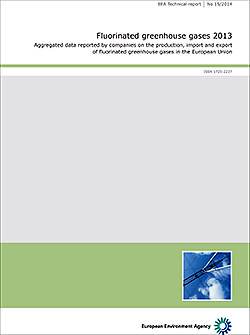HFC refrigerant use sees further decline
30th September 2014 EUROPE: The net supply of F-gases in Europe, the majority of which are used in refrigeration and air conditioning, declined again in 2013.
EUROPE: The net supply of F-gases in Europe, the majority of which are used in refrigeration and air conditioning, declined again in 2013.
The latest figures from the European Environment Agency reveal a third consecutive year of falling demand with net supply levels now slightly below the low levels of the ‘economic crisis’ year 2009. Net supply in 2013 dropped by 2.4% in terms of metric tonnes and 1.4% in CO2‑equivalents, which is close to the decrease rates observed for 2012 compared to 2011.
‘Net supply’ is defined as the actual use of (bulk) F-gases by EU industries. It is calculated from the total reported amounts for production, bulk imports, stocks held on January 1 of the reporting year and amounts collected for reclamation or destruction within the EU and subtracting reported amounts for bulk exports, destruction (on-site by reporting companies and off-site within the EU on reporting companies’ behalf), amounts used as feedstock by reporting companies and stocks held on December 31 of the reporting year.
The decrease in 2013 was dominated by the fall in the net supply of HFCs, which is by far the largest F-gas group. HFCs constituted 98% of the net supply in 2013, or 82% when measured in CO2‑equivalents.
The majority of F-gases net supplied to the EU market in 2013 were intended for refrigeration and air conditioning purposes and but has been declining since 2007. However, the figures do not include the amount of HFCs imported and exported in pre-charged equipment.

HFC134a, HFC125 and HFC143a are most relevant single HFCs, accounting for more than 80% of HFC net supply in 2013 if measured in metric tonnes and more than 90% if expressed in CO2‑equivalents. As refrigerants, those three gases are used to create the widely-used supermarket and commercial refrigeration blend R404A. R143a and R125 are also the two constituents of R507. With R404A and R507 – both high GWP refrigerants – targeted for bans under the forthcoming F-gas regulations it is clear to see what a huge effect this new legislation will have on supply figures in future years.
HFC125 (pentafluoroethane) is also used as a fire suppressant and is a component of R407C and R410A as well as being used in a number of lower GWP replacement blends.
HFC-32, a component (with R125) of R410A, and the aerosol and foam propellants HFC‑152a and HFC-365mfc are the next most relevant substances.
Production
Production of F-gases has also declined for the third consecutive year since 2010. Although in terms of CO2‑equivalents, the 8% decrease in 2013 followed four years of growth, this was mainly due to the production of SF6 which is used in electrical equipment. HFC production has been declining steadily since 2010
F-gas production in 2013, in terms of metric tonnes, is dominated by HFCs. However, expressed in CO2‑equivalents, SF6 accounts for a considerable share.
Imports
Imports of F-gases rose by 12 % in terms of CO2‑equivalents in 2013 compared to 2012. This is the first rise since 2010 where a sharp increase had been observed after the 2009 ‘economic crisis’ year. Overall 2013 imports are at approximately the same level as in 2011. F-gas imports in 2013 are almost entirely HFC imports (92 % in CO2‑equivalents).
Exports
Exports of F-gases have been on the rise since 2009; when expressed in metric tonnes, however, they are still below 2007 levels. The year-on-year increase from 2012 to 2013 was 2%. Expressed in CO2‑equivalents, however, 2013 exports dropped by 3%. This is because SF6 exports dropped by 7% compared to 2012, while HFC exports increased 3.1 % (metric tonnes) or 1.4 % (CO2‑equivalents).







